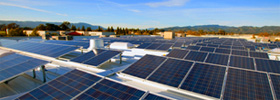 
|
|
|
|

News & ViewsReturn To Main →
HISTORY OF SOLAR
TIMELINE OF MAJOR MILESTONES IN SOLAR POWER HISTORY
1700's-1800's | 1900's-1950's | 1960's-1970's | 1980's-1990's | 2000's 1767 Swiss scientist Horace de Saussure was credited with building the world’s first solar collector, later used by Sir John Herschel to cook food during his South Africa expedition in the 1830s. 1816 On September 27, 1816, Robert Stirling applied for a patent for his economiser at the Chancery in Edinburgh, Scotland. By trade, Robert Stirling was actually a minister in the Church of Scotland and he continued to give services until he was eighty-six years old! But, in his spare time, he built heat engines in his home workshop. Lord Kelvin used one of the working models during some of his university classes. This engine was later used in the dish/Stirling system, a solar thermal electric technology that concentrates the sun’s thermal energy in order to produce power. 1839 French scientist Edmond Becquerel discovers the photovoltaic effect while experimenting with an electrolytic cell made up of two metal electrodes placed in an electricity-conducting solution—electricity-generation increased when exposed to light. 1860s French mathematician August Mouchet proposed an idea for solar-powered steam engines. In the following two decades, he and his assistant, Abel Pifre, constructed the first solar powered engines and used them for a variety of applications. These engines became the predecessors of modern parabolic dish collectors. 1873 Willoughby Smith discovered the photoconductivity of selenium. 1876 William Grylls Adams and Richard Evans Day discover that selenium produces electricity when exposed to light. Although selenium solar cells failed to convert enough sunlight to power electrical equipment, they proved that a solid material could change light into electricity without heat or moving parts. 1880 Samuel P. Langley, invents the bolometer, which is used to measure light from the faintest stars and the sun’s heat rays. It consists of a fine wire connected to an electric circuit. When radiation falls on the wire, it becomes very slightly warmer. This increases the electrical resistance of the wire. 1883 Charles Fritts, an American inventor, described the first solar cells made from selenium wafers. 1887 Heinrich Hertz discovered that ultraviolet light altered the lowest voltage capable of causing a spark to jump between two metal electrodes. 1891 Baltimore inventor Clarence Kemp patented the first commercial solar water heater. Back To Top 1904 Wilhelm Hallwachs discovered that a combination of copper and cuprous oxide is photosensitive. 1905 Albert Einstein published his paper on the photoelectric effect (along with a paper on his theory of relativity). 1908 William J. Bailley of the Carnegie Steel Company invents a solar collector with copper coils and an insulated box—roughly, it’s present design. 1914 The existence of a barrier layer in photovoltaic devices was noted. 1916 Robert Millikan provided experimental proof of the photoelectric effect. 1918 Polish scientist Jan Czochralski developed a way to grow single-crystal silicon. 1921 Albert Einstein wins the Nobel Prize for his theories (1904 research and technical paper) explaining the photoelectric effect. 1932 Audobert and Stora discover the photovoltaic effect in cadmium sulfide (CdS). 1947 1947 Passive solar buildings in the United States were in such demand, as a result of scarce energy during the prolonged W.W.II, that Libbey-Owens-Ford Glass Company published a book entitled Your Solar House, which profiled forty-nine of the nation’s greatest solar architects. 1953 Dr. Dan Trivich, Wayne State University, makes the first theoretical calculations of the efficiencies of various materials of different band gap widths based on the spectrum of the sun. 1954 Photovoltaic technology is born in the United States when Daryl Chapin, Calvin Fuller, and Gerald Pearson develop the silicon photovoltaic (PV) cell at Bell Labs—the first solar cell capable of converting enough of the sun’s energy into power to run everyday electrical equipment. Bell Telephone Laboratories produced a silicon solar cell with 4% efficiency and later achieved 11% efficiency. 1955 Western Electric began to sell commercial licenses for silicon photovoltaic (PV) technologies. Early successful products included PV-powered dollar bill changers and devices that decoded computer punch cards and tape. Architect Frank Bridgers designed the world’s first commercial office building using solar water heating and passive design. This solar system has been continuously operating since that time and the Bridgers-Paxton Building, is now in the National Historic Register as the world’s first solar heated office building. 1956 William Cherry, U.S. Signal Corps Laboratories, approaches RCA Labs’ Paul Rappaport and Joseph Loferski about developing photovoltaic cells for proposed orbiting Earth satellites. 1957 Hoffman Electronics achieved 8% efficient photovoltaic cells. 1958 T. Mandelkorn, U.S. Signal Corps Laboratories, fabricates n-on-p silicon photovoltaic cells (critically important for space cells; more resistant to radiation). Hoffman Electronics achieves 9% efficient photovoltaic cells. The Vanguard I space satellite used a small (less than one watt) array to power its radios. Later that year, Explorer III, Vanguard II, and Sputnik-3 were launched with PV-powered systems on board. Despite faltering attempts to commercialize the silicon solar cell in the 1950s and 60s, it was used successfully in powering satellites. It became the accepted energy source for space applications and remains so today. 1959 Hoffman Electronics achieves 10% efficient, commercially available photovoltaic cells. Hoffman also learns to use a grid contact, reducing the series resistance significantly. On August 7, the Explorer VI satellite is launched with a photovoltaic array of 9600 cells (1 cm x 2 cm each). Then, on October 13, the Explorer VII satellite is launched. Back To Top 1960 Hoffman Electronics achieves 14% efficient photovoltaic cells. 1960 Silicon Sensors, Inc., of Dodgeville, Wisconsin, is founded. It starts producing selenium and silicon photovoltaic cells. 1962 Bell Telephone Laboratories launches the first telecommunications satellite, the Telstar (initial power 14 watts). 1963 Sharp Corporation succeeds in producing practical silicon photovoltaic modules. Japan installs a 242-watt, photovoltaic array on a lighthouse, the world’s largest array at that time. 1964 NASA launches the first Nimbus spacecraft—a satellite powered by a 470-watt photovoltaic array. 1965 Peter Glaser conceives the idea of the satellite solar power station. 1966 NASA launches the first Orbiting Astronomical Observatory, powered by a 1-kilowatt photovoltaic array, to provide astronomical data in the ultraviolet and X-ray wavelengths filtered out by the earth’s atmosphere. 1969 The Odeillo solar furnace, located in Odeillo, France was constructed. This featured an 8-story parabolic mirror. 1970 Dr. Elliot Berman, with help from Exxon Corporation, designs a significantly less costly solar cell, bringing price down from $100 a watt to $20 a watt. Solar cells begin to power navigation warning lights and horns on many offshore gas and oil rigs, lighthouses, railroad crossings and domestic solar applications began to be viewed as sensible applications in remote locations where gridconnected utilities could not exist affordably. 1972 The French install a cadmium sulfide (CdS) photovoltaic system to operate an educational television at a village school in Niger. The Institute of Energy Conversion is established at the University of Delaware to perform research and development on thin-film photovoltaic (PV) and solar thermal systems, becoming the world’s first laboratory dedicated to PV research and development. 1973 The University of Delaware builds "Solar One," one of the world's first photovoltaic (PV) powered residences. The system is a PV/thermal hybrid. The roof-integrated arrays fed surplus power through a special meter to the utility during the day and purchased power from the utility at night. In addition to electricity, the arrays acted as flat-plate thermal collectors, with fans blowing the warm air from over the array to phase-change heat-storage bins. 1976 The NASA Lewis Research Center starts installing 83 photovoltaic power systems on every continent except Australia. These systems provide such diverse applications as vaccine refrigeration, room lighting, medical clinic lighting, telecommunications, water pumping, grain milling, and classroom television. The Center completed the project in 1995, working on it from 1976-1985 and then again from 1992-1995. David Carlson and Christopher Wronski, RCA Laboratories, fabricate first amorphous silicon photovoltaic cells. 1977 The U.S. Department of Energy launches the Solar Energy Research Institute "National Renewable Energy Laboratory", a federal facility dedicated to harnessing power from the sun. Total photovoltaic manufacturing production exceeds 500 kilowatts. 1978 1978 NASA’s Lewis Research Center dedicates a 3.5-kilowatt photovoltaic (PV) system it installed on the Papago Indian Reservation located in southern Arizona—the world’s first village PV system. The system is used to provide for water pumping and residential electricity in 15 homes until 1983, when grid power reached the village. The PV system was then dedicated to pumping water from a community well. Back To Top 1980 ARCO Solar becomes the first company to produce more than 1 megawatt of photovoltaic modules in one year. 1980 At the University of Delaware, the first thin-film solar cell exceeds 10% efficiency using copper sulfide/cadmium sulfide. 1981 Paul MacCready builds the first solar-powered aircraft—the Solar Challenger—and flies it from France to England across the English Channel. The aircraft had over 16,000 solar cells mounted on its wings, which produced 3,000 watts of power. 1982 The first, photovoltaic megawatt-scale power station goes on-line in Hisperia, California. It has a 1-megawatt capacity system, developed by ARCO Solar, with modules on 108 dual-axis trackers. Australian Hans Tholstrup drives the first solar-powered car—the Quiet Achiever—almost 2,800 miles between Sydney and Perth in 20 days—10 days faster than the first gasoline-powered car to do so. Tholstrup is the founder of "World Solar Challenge" in Australia, considered the world championship of solar car racing. The U.S. Department of Energy, along with an industry consortium, begins operating Solar One, a 10-megawatt central-receiver demonstration project. The project established the feasibility of power-tower systems, a solar-thermal electric or concentrating solar power technology. In 1988, the final year of operation, the system could be dispatched 96% of the time. Volkswagen of Germany begins testing photovoltaic arrays mounted on the roofs of Dasher station wagons, generating 160 watts for the ignition system. The Florida Solar Energy Center's "Southeast Residential Experiment Station" begins supporting the U.S. Department of Energy's photovoltaics program in the application of systems engineering. Worldwide photovoltaic production exceeds 9.3 megawatts. 1983 ARCO Solar dedicates a 6-megawatt photovoltaic substation in central California. The 120-acre, unmanned facility supplies the Pacific Gas & Electric Company’s utility grid with enough power for 2,000-2,500 homes. Solar Design Associates completes a stand-alone, 4-kilowatt powered home in the Hudson River Valley. Worldwide photovoltaic production exceeds 21.3 megawatts, with sales of more than $250 million. 1984 The Sacramento Municipal Utility District commissions its first 1-megawatt photovoltaic electricity generating facility. 1985 The University of South Wales breaks the 20% efficiency barrier for silicon solar cells under 1-sun conditions. 1986 The world’s largest solar thermal facility, located in Kramer Junction, California, was commissioned. The solar field contained rows of mirrors that concentrated the sun’s energy onto a system of pipes circulating a heat transfer fluid. The heat transfer fluid was used to produce steam, which powered a conventional turbine to generate electricity. ARCO Solar releases the G-4000—the world’s first commercial thin-film power module. 1988 Dr. Alvin Marks receives patents for two solar power technologies he developed: Lepcon and Lumeloid. Lepcon consists of glass panels covered with a vast array of millions of aluminum or copper strips, each less than a micron or thousandth of a millimeter wide. As sunlight hits the metal strips, the energy in the light is transferred to electrons in the metal, which escape at one end in the form of electricity. Lumeloid uses a similar approach but substitutes cheaper, film-like sheets of plastic for the glass panels and covers the plastic with conductive polymers, long chains of molecular plastic units. 1991 President George Bush redesignates the U.S. Department of Energy’s Solar Energy Research Institute as the National Renewable Energy Laboratory. 1992 University of South Florida develops a 15.9% efficient thin-film photovoltaic cell made of cadmium telluride, breaking the 15% barrier for the first time for this technology. A 7.5-kilowatt prototype dish system using an advanced stretched-membrane concentrator becomes operational. 1993 Pacific Gas & Electric completes installation of the first grid-supported photovoltaic system in Kerman, California. The 500-kilowatt system was the first "distributed power" effort. 1994 The National Renewable Energy Laboratory (formerly the Solar Energy Research Institute) completes construction of its "Solar Energy Research Facility", which was recognized as the most energy-efficient of all U.S. government buildings worldwide. It features not only solar electric system, but also a passive solar design. First solar dish generator using a free-piston Stirling engine is tied to a utility grid. The National Renewable Energy Laboratory develops a solar cell—made from gallium indium phosphide and gallium arsenide—that becomes the first one to exceed 30% conversion efficiency. 1996 The world’s most advanced solar-powered airplane, the Icare, flew over Germany. The wings and tail surfaces of the Icare are covered by 3,000 super-efficient solar cells, with a total area of 21m². The U.S. Department of Energy, along with an industry consortium, begins operating Solar Two—an upgrade of its Solar One concentrating solar power tower project. Operated until 1999, Solar Two demonstrated how solar energy can be stored efficiently and economically so that power can be produced even when the sun isn't shining. It also fostered commercial interest in power towers. 1998 The remote-controlled, solar-powered aircraft, "Pathfinder" sets an altitude record, 80,000 feet, on its 39th consecutive flight on August 6, in Monrovia, California. This altitude is higher than any prop-driven aircraft thus far. Subhendu Guha, a noted scientist for his pioneering work in amorphous silicon, led the invention of flexible solar shingles, a roofing material and state-of-the-art technology for converting sunlight to electricity. 1999 Construction was completed on 4 Times Square, the tallest skyscraper built in the 1990s in New York City. It incorporates more energy-efficient building techniques than any other commercial skyscraper and also includes building-integrated photovoltaic (BIPV) panels on the 37th through 43rd floors on the southand west-facing facades that produce a portion of the buildings power. Spectrolab, Inc. and the National Renewable Energy Laboratory develop a photovoltaic solar cell that converts 32.3 percent of the sunlight that hits it into electricity. The high conversion efficiency was achieved by combining three layers of photovoltaic materials into a single solar cell. The cell performed most efficiently when it received sunlight concentrated to 50 times normal. To use such cells in practical applications, the cell is mounted in a device that uses lenses or mirrors to concentrate sunlight onto the cell. Such "concentrator" systems are mounted on tracking systems that keep them pointed toward the sun. The National Renewable Energy Laboratory achieves a new efficiency record for thin-film photovoltaic solar cells. The measurement of 18.8 percent efficiency for the prototype solar cell topped the previous record by more than 1%. Cumulative worldwide installed photovoltaic capacity reaches 1000 megawatts. Back To Top 2000 First Solar begins production in Perrysburg, Ohio, at the world’s largest photovoltaic manufacturing plant with an estimated capacity of producing enough solar panels each year to generate 100 megawatts of power. At the International Space Station, astronauts begin installing solar panels on what will be the largest solar power array deployed in space. Each “wing” of the array consists of 32,800 solar cells. Sandia National Laboratories develops a new inverter for solar electric systems that will increase the safety of the systems during a power outage. Inverters convert the direct current (DC) electrical output from solar systems into alternating current (AC), which is the standard current for household wiring and for the power lines that supply electricity to homes. Two new thin-film solar modules, developed by BP Solarex, break previous performance records. The company’s 0.5-square-meter module achieves 10.8 % conversion efficiency—the highest in the world for thin-film modules of its kind. And its 0.9-square-meter module achieved 10.6% conversion efficiency and a power output of 91.5 watts — the highest power output for any thin-film module in the world. A family in Morrison, Colorado, installs a 12-kilowatt solar electric system on its home—the largest residential installation in the United States to be registered with the U.S. Department of Energy's "Million Solar Roofs" program. The system provides most of the electricity for the 6,000- square-foot home and family of eight. 2001 Home Depot begins selling residential solar power systems in three of its stores in San Diego, California. A year later it expands sales to include 61 stores nationwide. NASA’s solar-powered aircraft—Helios sets a new world record for non-rocketpowered aircraft: 96,863 feet, more than 18 miles high. The National Space Development Agency of Japan, or NASDA, announces plans to develop a satellite-based solar power system that would beam energy back to Earth. A satellite carrying large solar panels would use a laser to transmit the power to an airship at an altitude of about 12 miles, which would then transmit the power to Earth. TerraSun LLC develops a unique method of using holographic films to concentrate sunlight onto a solar cell. Concentrating solar cells typically use Fresnel lenses or mirrors to concentrate sunlight. TerraSun claims that the use of holographic optics allows more selective use of the sunlight, allowing light not needed for power production to pass through the transparent modules. This capability allows the modules to be integrated into buildings as skylights. PowerLight Corporation places online in Hawaii the world’s largest hybrid system that combines the power from both wind and solar energy. The gridconnected system is unusual in that its solar energy capacity—175 kilowatts— is actually larger than its wind energy capacity of 50 kilowatts. Such hybrid power systems combine the strengths of both energy systems to maximize the available power. British Petroleum (BP) and BP Solar announce the opening of a service station in Indianapolis that features a solar-electric canopy. The Indianapolis station is the first U.S. “BP Connect” store, a model that BP intends to use for all new or significantly revamped BP service stations. The canopy is built using translucent photovoltaic modules made of thin films of silicon deposited onto glass. Powerlight Corporation installs the largest rooftop solar power system in the United States—a 1.18 megawatt system—at the Santa Rita Jail in Dublin, California. 2002 NASA successfully conducts two tests of a solar-powered, remote-controlled aircraft called Pathfinder Plus. In the first test in July, researchers demonstrated the aircraft’s use as a high-altitude platform for telecommunications technologies. Then, in September, a test demonstrated its use as an aerial imaging system for coffee growers. Union Pacific Railroad installs 350 blue-signal rail yard lanterns, which incorporate energy saving light-emitting diode (LED) technology with solar cells, at its North Platt, Nebraska, rail yard—the largest rail yard in the United States. ATS Automation Tooling Systems Inc. in Canada starts to commercialize an innovative method of producing solar cells, called Spheral Solar technology. The technology—based on tiny silicon beads bonded between two sheets of aluminum foil—promises lower costs due to its greatly reduced use of silicon relative to conventional multicrystalline silicon solar cells. The technology is not new. It was championed by Texas Instruments (TI) in the early 1990s. But despite U.S. Department of Energy (DOE) funding, TI dropped the initiative. The largest solar power facility in the Northwest—the 38.7-kilowatt White Bluffs Solar Station—goes online in Richland, Washington. Back To Top Source Acknowledgement: Shamrock Renewable Group acknowledges information provided by the U.S. Department of Energy (www.eere.energy.gov) as source material for this section of the website. |

|

 
Shamrock Renewable Energy Services, Inc.
Bishop Ranch 3 2603 Camino Ramon, Suite 200 San Ramon, CA 94583
925.242.2037 (Tel)
info@shamrockrenewable.com
925.648.9673 (Fax) |
Website Design By KYLECREATIONS
© 2012-13 Shamrock Renewable Energy Services, Inc. All rights reserved. |














